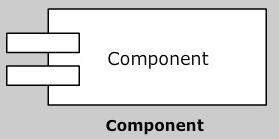Introduction to the Architectural Modeling in UML
Components
- A component is a physical and replaceable part of a system that conforms to and provide the realization of a set of interfaces
- It is used to model physical things like executable's, libraries, tables, files and documents
- Graphically represented as a rectangle with tabs

- Names
- Components and Classes
- Components and Interfaces
- Binary Replace ability
- Kinds of Components
- Common Modeling Techniques
Names:
Name of every component should be unique, in order to distinguish it from other components
It has simple and path names

Components and Classes:
Classes represent logical abstractions where as components represent physical things representing physical packaging
Classes have attributes and operations where as components have only operations which are reachable through their interfaces

Components and Interfaces:
The relationship between component and interfaces can be shown by connecting the component that realizes interface either by an elided or full realization relationship
In both ways, the component to the interface is connected by dependency relationship

Binary Replace ability:
➤A component is
- Physical, it lives in the world of bits not in concepts
- Replaceable, it is possible to replace a component with another that conforms to the same interfaces
- Part of a system, it rarely stands alone
Kinds of Components:
Deployment Components: These components form an executable system like Dynamic Libraries (DLLs) and Executables (EXEs)
Work Product Components: These components contains source code files and data files from which deployment components are created
Execution Components: These components are created as a consequence of an executing system, like COM+ object which is instantiated from a DLL
Post a Comment
Post a Comment